St Peter's Church, Bournemouth
St Peter's Church is a Church of England parish church located in the centre of Bournemouth, Dorset, England. It is a Grade I listed building classed as a 'major parish church', and was completed in 1879 to a design by G.E. Street as the founding mother church of Bournemouth. The building incorporates work by some of the finest Gothic Revival architects and artists, including Street, George Frederick Bodley, Ninian Comper, Arthur Blomfield and Edward Burne-Jones, with stained glass and frescoes by Clayton and Bell. The chancel has been described as 'one of the richest Gothic Revival interiors in England'.[1] The 202-foot (62 m)-high spire is a landmark in Bournemouth's centre, where it is the Town Centre Parish Church, together with the churches of St. Stephen and St. Augustine.
| St Peter's Church, Bournemouth | |
|---|---|
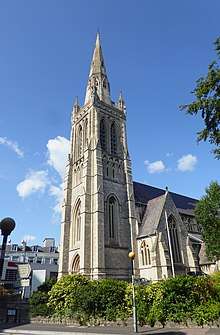 St Peter's Church from the South, showing the massive Tower and Spire which reaches a height of 202 ft. | |
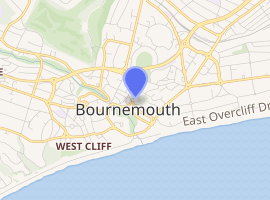
| |
| 50.7205°N 1.8755°W | |
| Denomination | Church of England |
| Website | Official website of St Peter's |
| History | |
| Status | Parish Church |
| Dedication | Saint Peter |
| Architecture | |
| Architect(s) | G.E. Street |
| Style | Gothic Revival |
| Completed | 1879 |
| Specifications | |
| Height | Spire 202 feet (62 m) |
| Floor area | 1176m2 |
| Materials | Purbeck stone with Bath stone dressings |
| Administration | |
| Parish | Bournemouth Town Centre |
| Deanery | Bournemouth |
| Archdeaconry | Archdeaconry of Bournemouth |
| Diocese | Diocese of Winchester |
| Province | Province of Canterbury |
| Clergy | |
| Rector | The Revd Dr Ian Terry |
| Laity | |
| Organist/Director of music | Duncan Courts |
| Organist(s) | Neil Sissons |
| Churchwarden(s) | Jane MacDonald-Styslinger |
Architecture
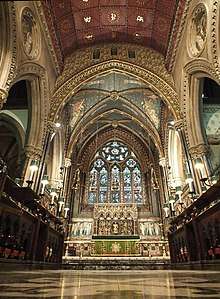
St. Peter's was built over a period of twenty-four years from 1855 at the instigation of the vicar, the Reverend Alexander Morden Bennett, to replace an earlier building. G.E. Street was commissioned to create a finer church to match the beauty of the town. It was the founding church of Bournemouth and was constructed between 1854 and 1879 on the foundations of the 1840s predecessor. G.E. Street later designed the Royal Courts of Justice in The Strand in London.
The 202-foot (62 m) spire is a landmark across the town centre and beyond.[2] It has unusual paintings, notable stained glass and alabaster. The church has a footprint of nearly 1200m2 and is classed as 'very large'.
Clergy
The team rector is the Reverend Dr. Ian Terry, who joined the parish in September 2009. Ian and his family had been previously based in Hereford for seven years, where he was Diocesan Director of Education and Honorary Team Vicar in the West Hereford Team.[3]
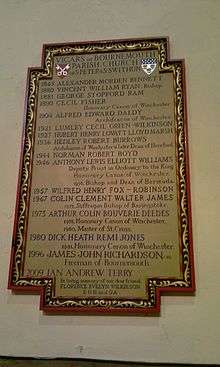
Vicars of St. Peter's[4]
- 1845 – Alexander Morden Bennett
- 1880 – Vincent William Ryan
- 1881 – George Stopford Ram
- 1890 – Cecil Fisher
- 1904 – Alfred Edward Daldy (also Archdeacon of Winchester}
- 1921 – Lumley Cecil Green-Wilkinson
- 1927 – Hubert Henry Lovatt Lloyd Marsh
- 1936 – Hedley Robert Burrows (also Archdeacon of Winchester and later Dean of Hereford)
- 1944 – Norman Robert Boyd
- 1946 – Anthony Lewis Elliott Williams (later Bishop of Bermuda)
- 1957 – Wilfred Henry Fox-Robinson
- 1967 – Colin Clement Walter James (later Bishop of Winchester)
- 1973 – Arthur Colin Bouverie Deedes (later Master of St. Cross)
- 1980 – Dick Heath Remi Jones
- 1996 – James John Richardson (awarded the OBE in 2006 for services to the Church of England.[5])
- 2009 – Ian Andrew Terry
Music
St. Peter's has had a strong musical tradition since its foundation.
Choirs
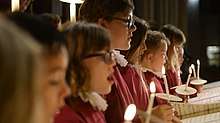
St. Peter’s has always maintained a choral tradition as a key part of its ministry. In 1865, on completion of the chancel and east transepts, a Choir Home was started, where half of the choristers (known as 'Home Boys') lived in the care of a matron, while the other half (known as 'Town Boys') lived in the town. All of the choristers were educated at St. Peter's School, which had opened in 1850 on land next to the church. The choir sang evensong every day, the Litany on Wednesday and Friday, and a total of four services each Sunday. As Bournemouth grew larger, there was less need to recruit choristers from far away, and the Choir Home was closed in 1924.
Today, the choir leads the music at two choral services each Sunday, with boys and girls joining to sing each week. Adult altos, tenors and basses sing with the trebles at each service.[6] Some services are sung by the St. Peter's Consort, a small group of adult singers specialising in unaccompanied works, particularly those of the Tudor period. The St. Peter's Singers, a mixed adult voluntary choir, sing for services during choir holidays.
Organs
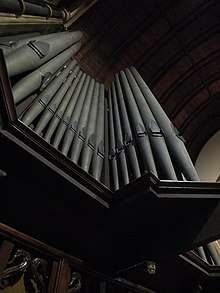
The Duncan and Bates Organs (1843–1870)
The first organ in St. Peter's was built for the opening of Tulloch's old 'Mock-Gothic' building of 1845. It was built by a Mr. J. Duncan of Poole, who was also the first organist. As Street's work began to replace the old building from 1855, this instrument was moved about, first from its west gallery to the new north aisle in 1856, then into the north-east transept soon after 1864 when the east end was completed. In this last position, with the majority of the new church complete, the organ was found to be 'nearly worn out' and of 'insufficient power'.[7] As a temporary measure, a second-hand instrument was bought from Vauxhall Pleasure Gardens in London, probably in 1865. This had been built by Bates of London in 1840, and originally consisted of seven stops on a single manual.[8] There is no record of its specification after being rebuilt in Bournemouth, but the organ was sold to St. John's, Carlton Hill in Brighton in 1870, and the pipework was later re-used in a 1997 instrument in St. Laurence, Falmer in East Sussex – this specification is not much larger. It is reasonable to speculate that the move to Bournemouth may have only added the Bourdon pedal pipes.[9] Nonetheless, contemporary sources described the Bates organ as 'ugly-looking' and as occupying the whole north transept. Funds were sought to provide a case and pipe decoration, but Alexander Morden Bennett desired an instrument more worthy of the church and attention quickly turned to the idea of a new organ.[10]
The Willis Organ (1870–1914)
In 1869 Alexander Morden Bennett placed an order with Henry Willis for a new organ costing £700. Street's new building was largely completed, lacking only west transepts and tower, and the temporary Bates instrument was ineffectual in the new building. Morden Bennett's choice may also have been influenced by the largely-new organ by Willis in nearby Christchurch Priory which was of a similar size to the new St. Peter's instrument and completed in 1865.[11] The entirely new organ, of 24 stops over three manuals and pedals and with 1292 pipes, was dedicated on St. Luke's Day in 1870. The organ occupied a chamber on the east side of the north transept, next to the sanctuary, and the front pipes were decorated with coloured diaper work in 1873 in keeping with its location.[12] The specification of the organ is here:.[13] Willis cleaned the instrument in 1892, but by 1912 it was described as 'nearly worn out and hardly worth repairing'.[14]
The Harrison Organ (1914 to present day)
In 1913, the church launched an appeal for a new and much larger organ, together with new purpose-built vestries on the north-east corner of the church. A contract was signed with Harrison and Harrison of Durham to build an instrument of 48 stops over three manuals and pedals, eventually costing over £2700. The organ was built in a new chamber created in the space formerly occupied by the vestries on the east side of the north-east transept, and the area next to it formerly occupied by the Willis organ was made into a chapel. Much of the Willis pipework was incorporated into the new specification, which can be seen here:.[15] Arthur Harrison is said to have taken 'infinite pains with it, and had special difficulties to contend with owing to the distance of the instrument from the main body of the church'. A case for the new instrument was designed by Ninian Comper, but the estimated cost of £750 was never found and the instrument remains caseless except for plain dark pine panelling up to the pipe feet. The organ was overhauled by the Liverpool firm of Rushworth and Dreaper in 1976, increasing the size to 54 stops and adding a detached console on a moveable platform at the front of the nave. Cleaning and various repairs and modifications have taken place over the years, but following its centenary, the instrument is in need of significant restoration and maintenance.
Organists[16]
- 1859 – J.H. Caseley (formerly assistant organist, Worcester Cathedral)
- ? - William Henry Beare
- 1868? - Mr. Taylor
- 1869 – Thomas Burton
- 1880 – Duncan Hume
- 1905 – James Chandler BMus FRCO (formerly organist and choirmaster, All Saints, Wokingham)
- 1946 – Charles Palmer, BMus FRCO
- 1953 – Michael Peterson MA FRCO (later organist, Tewkesbury Abbey)
- 1966 – Harry Sayles (temporary appointment - formerly assistant organist, Guildford Cathedral)
- 1967 – Frederick Hewitt MA MusB FRCO
- 1968 – Cyril Knight FRCO
- 1971 – John Belcher MA FRCO (formerly assistant organist, Chester Cathedral, later organist, St Asaph Cathedral and Tewkesbury Abbey)
- 1981 – Dr. Martin Firth (né Freke) (later director of music, UWE)
- 1985 – Stephen Carleston MA FRCO (later director of music, Bolton Parish Church)
- 1993 – David Beeby BMus FRCO (now head of music, Poole Grammar School)
- 2002 – Charles Spanner BMus
- 2003 – Ben Lamb MusB (now director of music, Lichfield Cathedral)
- 2007 – Stephen Le Prevost BA FTCL (formerly assistant organist, Westminster Abbey)
- 2008 – David Coram (formerly assistant organist, Romsey Abbey)
- 2011 – Sam Hanson MA ARCO (formerly organ scholar, Jesus College, Cambridge)
- 2015 - Duncan Courts AdvDip CRCO (formerly assistant director of music)
Bells
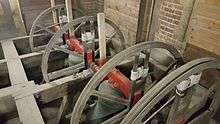
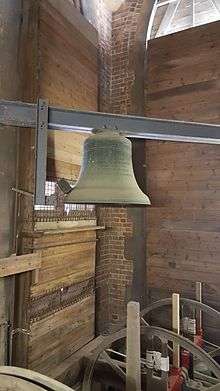
St. Peter's has the heaviest ring of bells in Bournemouth,[17] and was the first church in the town to receive a ring of bells. There are eight bells hung for full circle ringing in the English style of change ringing and a Sanctus bell which is chimed by a switch in the chancel.
When the tower was completed in 1870, it was intended to be equipped with a peal of bells, and a bell-chamber, ringing chamber, and circular stairway were provided. When Morden Bennett, the founding priest, succumbed to a serious illness, members of the church and town organised an appeal to raise funds for an additional six bells, augmenting the existing two, to honour him. The bells were manufactured by Taylor's of Loughborough and were dedicated at Whitsun in 1871, on Morden Bennett's recovery. At the dedication, the Ancient Society of College Youths rang a peal consisting of 518 grandsire triples, 672 and 216 Stedman's triples, and 576 treble bob majors.[18]
In 1936, the church proposed re-hanging and re-tuning the existing ring and adding a Sanctus bell as "a distinct and beautiful memorial" to Alfred Daldy, a previous incumbent who had died the previous year. It was found that the bells were in a poor state, and Taylor's suggested re-casting the bells because many improvements had been made in bell-casting since 1871, a transitional period in this skill. At the time, this was still the only peal of bells in Bournemouth, and after recasting by Taylor's, they were dedicated on 20 November 1937.[19]
| Number | Date | Note | Maker | Mass | ||
|---|---|---|---|---|---|---|
| long measure | lb | kg | ||||
| 1 | 1937 | E | John Taylor & Co | 5 long cwt 0 qr 2 lb | 562 | 255 |
| 2 | 1937 | D# | John Taylor & Co | 5 long cwt 2 qr 0 lb | 616 | 279 |
| 3 | 1937 | C# | John Taylor & Co | 5 long cwt 3 qr 13 lb | 657 | 298 |
| 4 | 1937 | B | John Taylor & Co | 7 long cwt 1 qr 3 lb | 815 | 370 |
| 5 | 1937 | A | John Taylor & Co | 9 long cwt 1 qr 8 lb | 1,044 | 474 |
| 6 | 1937 | G# | John Taylor & Co | 10 long cwt 3 qr 18 lb | 1,222 | 554 |
| 7 | 1937 | F# | John Taylor & Co | 15 long cwt 0 qr 2 lb | 1,682 | 763 |
| 8 | 1937 | E | John Taylor & Co | 20 long cwt 2 qr 7 lb | 2,303 | 1,045 |
| Sanctus | 1937 | G | John Taylor & Co | 9 long cwt 2 qr 25 lb[20] | 1,089 | 494 |
Notable worshippers and burials
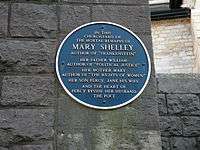
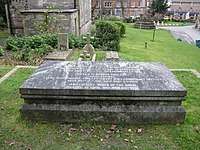
St Peter's has many famous connections.
- William Ewart Gladstone, the Prime Minister, took his last communion here.
- The composer Sir Hubert Parry was born in the parish in 1848 and baptised in St. Peter's, and his mother Isabella is buried in the churchyard.
- John Keble, one of the leaders of the Oxford Movement, vicar at All Saints' Hursley in the New Forest and professor of poetry at Oxford, died in the parish in 1866. There are two stained glass windows of him in his cassock in the church, and the Keble Chapel was dedicated in the south-east transept in his memory.
- Sir Dan Godfrey, who founded Bournemouth Symphony Orchestra in 1896 is buried here.
- Major General Richard Clement Moody, Governor of the Falkland Islands and Lieutenant Governor of British Columbia.
- Lewis Tregonwell, founder of Bournemouth. In 1810, Tregonwell bought land from the Lord of the Manor of Christchurch and built a house next to the mouth of the River Bourne (which runs through the lower gardens today). His house was called The Mansion, and is now part of the Royal Exeter Hotel.
- Mary Shelley, author of Frankenstein, is interred there, along with the heart of her husband, the poet Percy Bysshe Shelley, who had died abroad. Their only surviving child, Sir Percy Florence Shelley, built a house in nearby Boscombe, believing that the balmy climate would help his sick wife and his mother. Mary Shelley had expressed a wish to be buried with her parents, Mary Wollstonecraft, the feminist philosopher, and William Godwin, one of the founders of theoretical anarchism. Wollstonecraft and Godwin had died in London and were buried in the churchyard of St Pancras Old Church. Sir Percy and his wife had them dug up and moved to Bournemouth.
References
- Jenkins, Simon, 'England's Thousand Best Churches', Allen Lane, 1999, p.148
- Historic England. "St. Peter's Church, Bournemouth (1153014)". National Heritage List for England. Retrieved 3 September 2011.
- St Peter's Bournemouth accessed 16 January 2012
- Noticeboard in the church, located near the font
- St Peter's Bournemouth Archived 9 May 2008 at the Wayback Machine accessed 11 January 2008
- "Music at St. Peter's : St. Peter's Church : Bournemouth Town Centre Parish". btcp.org.uk. Retrieved 1 December 2015.
- McQueen, Ian, 'Bournemouth St. Peter's', Dorset Publishing Company, 1971, p.33-34, 53, 58
- "National Pipe Organ Register – Surrey (London, Greater), Vauxhall Pleasure Gardens". Retrieved 10 May 2013.
- "National Pipe Organ Register – Sussex (Sussex, East), Falmer St. Laurence". Retrieved 10 May 2013.
- McQueen, Ian, 'Bournemouth St. Peter's', Dorset Publishing Company, 1971, p.58
- "National Pipe Organ Register – Hampshire (Dorset), Christchurch Priory". Retrieved 10 May 2013.
- McQueen, Ian, 'Bournemouth St. Peter's', Dorset Publishing Company, 1971, p.59
- "National Pipe Organ Register – Hampshire (Dorset), Bournemouth St. Peter 1892". Retrieved 10 May 2013.
- McQueen, Ian, 'Bournemouth St. Peter's', Dorset Publishing Company, 1971, p.134
- "National Pipe Organ Register – Hampshire (Dorset), Bournemouth St. Peter 1914". Retrieved 10 May 2013.
- Church leaflet, 'The Organs of St. Peter's Church, Bournemouth'
- "Dove's Guide for Church Bell Ringers – Bournemouth". Retrieved 9 May 2013.
- Leachman, E.W., 'St. Peter's Bournemouth', Sydenham and Co., 1915, p.29
- McQueen, Ian, 'Bournemouth St. Peter's', Dorset Publishing Company, 1971, p.179-180
- "Dove's Guide for Church Bell Ringers – St. Peter's Bournemouth". Retrieved 9 May 2013.
External links
| Wikimedia Commons has media related to St Peter's Church, Bournemouth. |